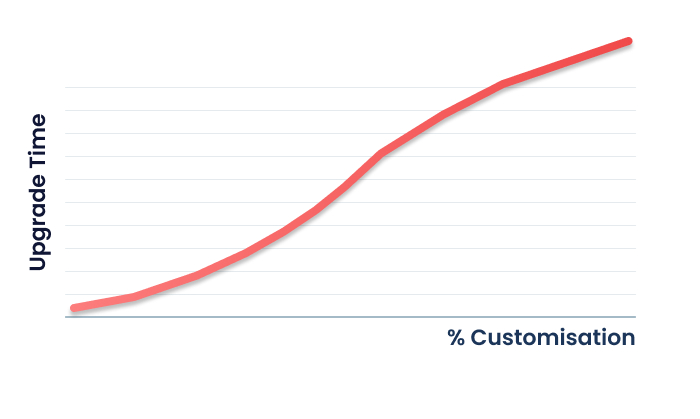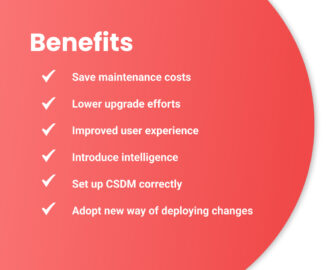Time for a new ServiceNow instance?

Quickly jump to
Once you’ve purchased a platform like ServiceNow, you need to keep assessing if you’re using the platform to its full potential. One of the errors we often see is allowing the business to determine ServiceNow functionality. This often leads to heavy customizations, high maintenance costs, lengthy upgrades, bad user experience, and so on. Those are RED FLAGS. Because this causes the platform to become a drag instead of it giving you a competitive advantage.
In these cases, we advise to start fresh with a new ServiceNow instance, which is what we call Going Back to Out of the Box, or OOTB. This will grant you instant access to all new ServiceNow features, makes upgrading easy, cuts maintenance costs, etc.
But I hear you thinking: WHAT?! You’re kidding, right? That’s crazy. It will take too much time, money, hassle and we’d be reinventing the wheel. The opposite is true, but we’ll explain that in a minute!
Let’s first explore all the red flags that could tell you it’s time for a new instance.
Not a fan of reading? Watch this story above or listen to it on Spotify.
The You-Need-A-New-Instance Red Flags
Lengthy platform upgrades
One of our customers, a large oil and gas company, had an average upgrade period of 10-12 weeks (!). The reason this took so long is that their instance had a high level of customization. Every single point of customization needed to be checked to make sure it didn’t impact other areas in the platform.
High maintenance costs
Do you need to keep a large maintenance team together because only they possess the knowledge of the way customizations were set up—resulting in high maintenance costs? That’s a red flag!
Data quality issues
Heavy customizations on your ServiceNow instance always result in having no visibility in the ownership or supporting services with respect to your data. As a result, data quality is bad, and the lack of ownership leads to confusion and finger pointing within the organization.
Slow platform performance
Reports and dashboards take extremely long to load. Fulfillers have to wait seconds for a page to load and employees are trying to navigate the portal but can’t and end up burdening your IT service desk. Because they don’t want to use the portal or self-service because it’s too slow and frustrating to use. That’s a sign that the platform is not giving you a competitive advantage anymore, simply because your employees are collectively wasting way too much time!
Two possible migration approaches
1. De-customization
This is the process of removing customizations (code) to clean up your ServiceNow instance and bring it back to out-of-the-box.
This approach is very expensive and unpredictable because you don’t know what the impact of de-customization is on other scripts. If you take away one piece of script here, you don’t know if it will break or alter another script. With scripts almost always being built on top of other scripts, you can imagine what a gigantic puzzle this would be!
2. New instance
This is our proven and advised approach. Although this might seem as reinventing the wheel, the opposite is true. ServiceNow has gone a long way in adopting industry standard practices like ITIL for IT Service Management for example. This means you’re following proven practices and theories from the industry.
Benefits of a new ServiceNow instance
![]() Save maintenance costs
Save maintenance costs
With no need for a big maintenance team anymore, you can save costs. Developers now have time to focus on innovation and user experience and you have flexibility in team composition again, meaning you’re not dependent on workers that know script correlations.
 Lower upgrade efforts
Lower upgrade efforts
With ServiceNow upgrading every 6 months, we often see an upgrade once or twice during a Back-to-out-of-the-Box project. For a major oil and gas company, going back to out-of-the-box meant that they were able to upgrade in just 1 day opposed to the 13 weeks it was before!
![]() Improved user experience
Improved user experience
The user experience that ServiceNow offers out-of-the-box—which is a way better than that of an over-customized ServiceNow instance—means you can finally use the platform to its full potential.
![]() Intelligent operations
Intelligent operations
A new instance also unlocks great new features like automation, machine learning, chatbots and intelligence. Stuff you dreamt of before is now suddenly at your disposal!
![]() Set up CSDM correctly
Set up CSDM correctly
A clean slate means you can also implement the all-important CSDM correctly. Organizing your data the way it was intended by ServiceNow will give you control and ownership over the services that you provide within your organization.
![]() Deploy changes easily
Deploy changes easily
ServiceNow is transitioning towards a DevOps approach for change deployment. They will no longer be working with Update Sets but instead deploy through scoped applications. A new instance provides you the opportunity to start using this new way of deploying functionality already.
Now that you’re aware of the red flags and benefits a new instance brings, and you notice that this applies to your organization, you might think: how on earth do you transition to a new instance? How do you mitigate risks?
That’s what we’ll be discussing in the sequel “How to transition to a new instance”. Stay tuned!

Join 1400+ ServiceNow professionals
Sign up to our monthly Flow@Work Exclusive newsletter to get free access to our expertise and lots of tips and tricks to make work flow on the Now® Platform.






